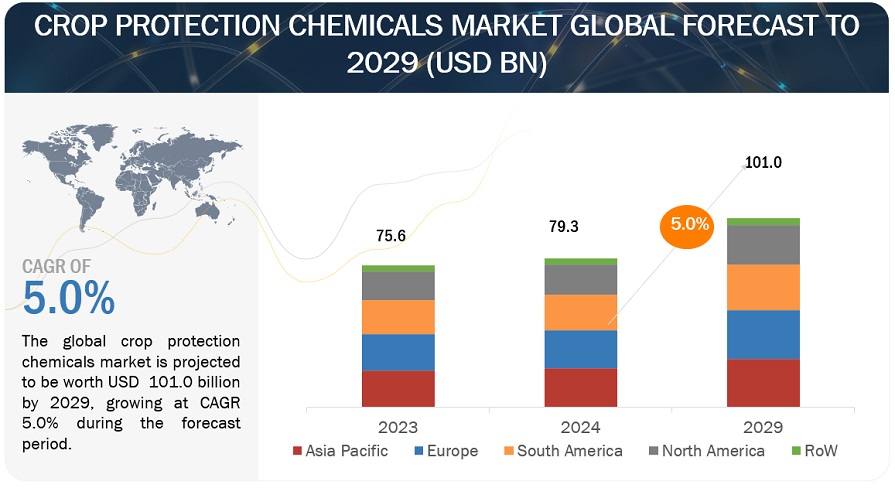The global crop protection chemicals market is projected to reach USD 101.0 billion by 2029 from USD 79.3 billion by 2024, at a CAGR of 5.0% during the forecast period in terms of value. Climate change is reshaping weather patterns, leading to emerging and persistent threats from pests and diseases. Warmer temperatures and altered precipitation can extend the range of pests, such as the fall armyworm, which has wreaked havoc on crops across Africa and Asia. This growing intensity and frequency of threats drive up the demand for crop protection chemicals to preserve yields. According to the Food and Agriculture Organization (FAO), 20–40% of global crop production is lost each year due to pests, underscoring the urgent need for effective protection measures. In response, governments around the world are enacting policies and providing subsidies to bolster the agricultural sector. For example, India’s Pradhan Mantri Fasal Bima Yojana (PMFBY) offers insurance to farmers for crop losses caused by pests and diseases, indirectly encouraging the use of crop protection chemicals. Additionally, regulatory frameworks ensure the safe and effective application of these chemicals, further promoting their adoption.

Crop Protection Chemicals Market Opportunities: Integrated pest management (IPM)
Integrated Pest Management (IPM) offers significant potential for the crop protection chemicals market by fostering a comprehensive and sustainable approach to pest control. IPM integrates chemical, biological, cultural, and physical methods to manage pests in a balanced manner. It emphasizes the careful use of crop protection chemicals, applying them only when needed and alongside other control methods to reduce environmental impact and avoid pest resistance. This approach drives the creation of more targeted and eco-friendly chemical products that align with IPM principles. As a result, it paves the way for innovation and growth in the market, with companies developing new formulations and technologies to meet the rising demand for sustainable and effective pest management solutions.
In the mode of application segment, seed treatment segment is expected to grow at highest CAGR during the forecast period.
Seed treatment involves applying crop protection chemicals directly to seeds before planting, aiming to protect them from pests, diseases, and other stressors during germination and early growth stages. This method offers several advantages, including efficient use of chemicals, targeted application, and minimal environmental impact compared to traditional spraying methods. The increasing adoption of precision agriculture and advancements in seed coating technologies contribute to the growing popularity of seed treatments. Moreover, seed treatment ensures uniform coverage and better efficacy, enhancing crop establishment and yield potential. As farmers seek cost-effective and sustainable solutions to maximize crop productivity, the seed treatment segment is expected to experience significant growth, driven by its effectiveness and compatibility with modern agricultural practices.
Download PDF Brochure: https://www.marketsandmarkets.com/pdfdownloadNew.asp?id=380
Why is the Asia-Pacific region expected to dominate the crop protection chemicals market during the forecast period?
The dominance and rapid growth of the region are driven by its extensive agricultural base and the growing need to boost crop yields to support a rapidly expanding population. Asia-Pacific, home to over 60% of the global population, sees leading agricultural production from countries like China and India. Agriculture plays a crucial role in their economies, making effective crop protection solutions vital for ensuring food security and economic stability. The region’s varied climatic conditions contribute to significant pest and disease challenges, further increasing the demand for crop protection chemicals. For example, pests like the Fall armyworm have caused major crop losses, leading governments and farmers to invest heavily in pest management solutions. Additionally, the rise of modern farming practices and technologies in countries such as Japan, Australia, and South Korea is driving the market for advanced crop protection products. Innovations like precision agriculture are optimizing chemical application, reducing waste, and enhancing effectiveness.
Top Crop Protection Chemicals Companies:
The key players in the market include BASF SE (Germany), Bayer AG (Germany), FMC Corporation (US), Syngenta Group (Switzerland), Corteva (US), UPL (India), Nufarm (Australia), Sumitomo Chemical Co., Ltd. (Japan), Albaugh LLC (US), Koppert (Netherlands), Gowan Company (US), American Vanguard Corporation (US), Kumiai Chemical Industry Co., Ltd. (Japan), PI Industries (India), and Chr. Hansen A/S (Denmark). These market participants are emphasizing the expansion of their footprint via agreements and partnerships. They maintain a robust presence in North America, Asia Pacific, South America, RoW, and Europe, and they are supported by manufacturing facilities and well-established distribution networks spanning these regions.
Crop Protection Chemicals Industry News
- In January 2024, Gowan Crop Protection Limited, an affiliate of Gowan Company, LLC, had entered into agreements with Syngenta Crop Protection AG to acquire global rights to the active ingredient cyromazine. The acquisition encompassed product registrations and trademarks, including TRIGARD and LEPICRON, along with related intellectual property and labels.
- In March 2023, Corteva solidified its position as a global leader in the rapidly expanding biologicals market by announcing the completion of its acquisitions of Symborg, an expert in microbiological technologies based in Murcia, Spain, and Stoller, one of the largest independent companies in the biologicals industry, based in Houston, Texas, US.
- In December 2023, Albaugh LLC announced that it had received registration from the U.S. Environmental Protection Agency for its Maxtron 4SC herbicide (EPA Reg. No. 45002-37). Maxtron 4SC, containing ethofumesate, is a broad-spectrum herbicide designed to selectively control key weeds such as annual sowthistle, puncturevine, and purple and yellow nutsedge in sugar beets, garlic, onions, and other crops. This approval bolstered Albaugh LLC’s position in the crop protection chemicals market by expanding its product lineup with a versatile and effective herbicide, enhancing its ability to meet the diverse weed control needs of farmers and improve crop yields.


